Construction Set To Begin On Virgin Islands Water and Power Authority Undergrounding Project
September 19, 2021
by Paul Ciampoli
APPA News Director
September 19, 2021
Construction is set to begin this week on the first electrical underground project in St. Croix, Virgin Islands, the Virgin Islands Water and Power Authority said on Sept. 17.
Undergrounding of equipment in and around the Wilfred “Bomba” Allick Port and Transshipment Center at Krause Lagoon is a $2.5 million federally funded project with financial resources provided by the Federal Emergency Management Agency and the U.S. Department of Housing and Urban Development. J. Benton Construction Inc. is the contractor on the project, which aims to provide critical facilities with electrical equipment that is less vulnerable to hurricanes and windstorms. The work entails trenching and conduit installation.
“The undergrounding of facilities in critical areas is key during storm restoration and other emergencies,” said Virgin Islands Water and Power Authority Interim Executive Director Noel Hodge said the Authority is excited about beginning construction on this very important mitigation project on St. Croix. Interim Executive Director Noel Hodge. “The ports are critical to the movement of materials and supplies into the territory after a disaster and providing facilities that can lead to more efficient power restoration, bodes well for the future.”
Hodge noted that in April, Virgin Islands Water and Power Authority broke ground on this and two similar underground electrical projects, in Golden Grove and Midland, “and we are now set to proceed with the start of construction on Tuesday.”
As with similar electrical undergrounding across the territory, the Container Port project will replace existing overhead electrical lines and equipment with underground equipment. “This lessens damage from future hurricanes and windstorms and also ensures more efficient service restoration in the aftermath of a natural disaster,” Hodge said.
Similar electrical undergrounding projects are slated for St. Thomas and St. John as part of a larger strategic transformation of the territory’s electrical and water utility.
OPPD Promotes Troy Via To Newly Created Position of COO, Vice President For Utility Operations
September 19, 2021
by Paul Ciampoli
APPA News Director
September 19, 2021
The Omaha Public Power District (OPPD) Board of Directors recently promoted Troy Via to the newly created position of Chief Operating Officer and Vice President for Utility Operations, effective Oct. 31.
Via is currently Vice President for Energy Delivery at Nebraska public power utility OPPD, having served in that role for the past three years.
He joined OPPD in September of 2013 as the Director of Energy Marketing and Trading. During his five-year tenure in that role, Via played a lead role in OPPD’s integration into the Southwest Power Pool and the District’s entry into the day-ahead market.

He actively engaged in enterprise risk management, including the development of OPPD’s derivative strategy. He has contributed significantly to economic development and played a key role on OPPD’s resource planning team. In addition, Via led the corporate Integrated Energy Marketplace strategic initiative.
In his new position, Via will provide overall leadership, strategic planning and long-term objectives for OPPD’s energy production and energy delivery groups. He will also oversee the ongoing decommissioning of the Fort Calhoun Station, a nuclear power plant that was shut down permanently on October 24, 2016.
The role will oversee the main energy operational capabilities to ensure OPPD’s continued commitment to affordable, reliable, and environmentally sensitive energy services.
Prior to joining OPPD, Via held progressively responsible positions with Dominion Resources and Aquila Energy.
He holds a bachelor of Business Administration degree with a focus in Finance from the University of Central Missouri.
WAPA Desert Southwest Region Agrees To Participate In CAISO’s Real-Time Energy Market
September 19, 2021
by APPA News
September 19, 2021
The California Independent System Operator (CAISO) on Sept. 15 signed an implementation agreement with the Western Area Power Administration Desert Southwest (WAPA DSW) region to participate in CAISO’s real-time energy market in 2023.
Operated by CAISO, the Western Energy Imbalance Market (EIM) footprint currently includes portions of Arizona, California, Idaho, Montana, Nevada, New Mexico, Oregon, Utah, Washington, and Wyoming, and extends to the border with Canada.
WAPA DSW sells federal hydroelectric power and provides transmission service to nearly 70 municipalities, cooperatives, Native American tribes, federal and state agencies, and irrigation districts. One of those cooperatives, the Arizona Electric Power Cooperative (AEPCO), is comprised of six electric distribution cooperatives and five public power entities that combined serve more than 420,000 residential, agriculture, business and industrial customers.
The agreement applies to WAPA’s DSW region and Western Area Lower Colorado Balancing Authority. The latter includes generation resources in the Boulder Canyon and Parker-Davis projects (PDP) and the transmission systems of the Central Arizona Project, PDP and the Pacific-Northwest-Pacific Southwest Intertie Project.
In addition to the AEPCO sub-Balancing Authority area, participating Balancing Authority entities include the Central Arizona Water Conservation District, Southwest Public Power Agency and other DSW customers in Arizona, southern California and southern Nevada.
By 2023, the Western EIM will have 22 entities representing 84%of the demand for electricity in the Western Electric Coordinating Council (WECC), a non-profit corporation that works to advance a reliable electric system in 14 Western states, Northern Baja Mexico, and two Canadian provinces.
WAPA annually markets and transmits more than 25,000 gigawatt-hours of renewable power from 57 federal hydroelectric powerplants owned and operated by the Bureau of Reclamation, U.S. Army Corps of Engineers and International Boundary and Water Commission in 15 western and central states. WAPA also owns, operates and maintains a more than 17,000 circuit-mile high-voltage transmission system in the West. It is part of the Department of Energy.
U.S. Storage Market Continued To Grow In The Second Quarter Of 2021
September 16, 2021
by Paul Ciampoli
APPA News Director
September 16, 2021
According to Wood Mackenzie and the U.S. Energy Storage Association’s (ESA) latest US Energy Storage Monitor report, 345 megawatts (MW) of new energy storage systems were brought online in the second quarter of 2021.
This is an increase of 162% over the same quarter in 2020, making the second quarter of 2021 the second-largest quarter on record by MW for U.S. energy storage additions. An unprecedented volume of storage will come online in in the second half of the year, with Wood Mackenzie expecting that storage projects representing over $5 billion of investment will come online in 2021 alone.
Details on the report were released on Sept. 9.
Despite positive market momentum in the U.S., the residential battery storage market dipped slightly, the first drop for the segment in nine quarters (since Q4 2018). Equipment constraints, including an ongoing Tesla Powerwall shortage, is hampering the segment’s growth despite the proliferation of new residential storage players, the report noted.
The non-residential segment, which consists of onsite storage and community-scale storage, saw quarter-on-quarter deployments rise by 31%, driven by the growth of the community storage market in Massachusetts.
The front-of-the-meter (FTM) market deployed 218 MW/729 megawatt hours (MWh) in Q2 2021, with California, Texas and Arizona leading the segment. California continued to lead the front-of-the-meter segment in Q2, with Arevon/Capital Dynamics’s 100MW/400MWh Saticoy Energy Storage peaker plant replacement in Ventura County, Calif., contributing most of the MW for the quarter. Solar-plus-storage projects in Texas and Arizona also bolstered Q2 front-of-the meter capacity.
Meanwhile, policy support continued to build in Q2, with several new state incentives introduced for residential and non-residential storage. The industry also still awaits the outcome of budget reconciliation, expected this winter, which could include a solar investment tac credit (ITC) extension and/or standalone storage ITC. A positive outcome would upgrade the energy forecast across all segments, Wood Mackenzie and ESA said.
Blue Ridge Power Agency Issues Battery Energy Storage System Request for Proposals
September 16, 2021
by Paul Ciampoli
APPA News Director
September 16, 2021
Virginia-based Blue Ridge Power Agency (BRPA) has issued a request for proposals (RFP) in which the joint action agency seeks pricing for several battery energy storage system (BESS) configurations that will aggregate to form a portfolio of BESS assets.
BRPA members are non-profit entities from six municipalities, towns, two cooperatives, and a university located in Virginia, each of which owns and operates its public power electric distribution system.
There will be four member projects participating in the RFP for this BRPA portfolio. The locations in the RFP will be strategically spread out across four members to capture benefits from BRPA’s member demand side management (DSM) activities.
The BESS sites are contemplated to be at locations provided by Craig Botetourt Electric Cooperative in Virginia, City of Radford, Va., City of Salem, Va., and Virginia Tech Electrical Services.
BRPA is seeking competitive proposals for a BESS to support BRPA’s DSM activities.
As outlined in the RFP, BRPA is looking for pricing for several BESS system configurations (2, 5, and 10 megawatt capacity ratings) that will aggregate to form a portfolio of BESS assets.
BRPA intends to select these configurations based on site-specific costs and project evaluation criteria. Commercial operation for the BESS is scheduled for June 2023.
Potential respondents can request the RFP and other information by contacting BRPA’s consultant, GDS Associates, Inc. Questions concerning the RFP should be directed to the following email address: BRPA.2021BatteryRFP@gdsassociates.com
Proposals in response to the RFP are due Nov. 1, 2021.
The American Public Power Association’s Public Power Energy Storage Tracker is a resource for association members that summarizes energy storage projects undertaken by members that are currently online.
Ditto Writes In Support Of Bond And Tax Credit Provisions In Legislation
September 15, 2021
by Paul Ciampoli
APPA News Director
September 15, 2021
In a Sept. 14 letter to House Ways and Means Committee Chairman Richard Neal, D-Mass., Joy Ditto, President and CEO of the American Public Power Association (APPA), applauds the infrastructure financing and energy-related provisions of the tax titles of the Build Back Better Act that are being considered for adoption this week by the committee.
“These provisions will reduce the cost of financing infrastructure investments overall and ensure that all electric utilities, including APPA’s not-for-profit members, can benefit from incentives intended to encourage critical energy investments needed to transition to cleaner generating technologies. This will make these incentives fairer and more effective,” wrote Ditto.
She noted that state and local governments and the enterprises they govern use municipal bonds to finance public infrastructure investments that enable their communities to function and thrive. Tax-exempt municipal bonds have financed $2.3 trillion in new investments in infrastructure over the last decade, including $68 billion in new investments in electric power generation, transmission, and distribution.
In Subtitle F (Infrastructure Financing and Community Development), the Build Back Better Act “includes hugely important provisions to improve tax-exempt financing, including reinstating the ability to issue tax-exempt advance refunding bonds and increasing the small-issuer exception threshold from $10 million to $30 million,” Ditto wrote.
Increasing the small issuer exception to $30 million will make it more attractive for banks to invest in rural and other smaller communities. And in the five years prior to their repeal in 2017, public power utilities refinanced $20 billion in existing debt with tax-exempt advance refunding bonds — generating interest savings of more than $600 million for the communities they serve, Ditto said.
Likewise, Subtitle G (Green Energy) “takes transformational steps to making energy-related tax provisions more efficient and fairer,” the APPA President and CEO said.
Federal tax expenditures are the primary tool Congress uses to incentivize energy-related investments. “However, such incentives do not work for tax-exempt entities (including public power utilities). That means public power utilities are effectively locked out of owning such facilities – and explains why 80 percent of the nation’s (non-hydropower) renewable energy generating capacity is owned by for-profit, merchant generators,” wrote Ditto.
Subtitle G addresses this inequity by allowing for the direct payment of energy production and investment tax credits and carbon capture tax credits to any entity that owns the project. “This would remove the financial disincentive for public power utilities to own such facilities, which are needed to transition to cleaner generating technologies and to address climate change. That means local projects, under local control creating local jobs. It also would allow the full value of these credits to pay for additional investment or be passed on to our 49 million customers,” Ditto said.
She thanked Neal for his “continued commitment to helping local communities find and finance local solutions” and said that the changes in bond financing and energy-related tax credits that the Ways and Means Committee is considering this week “will give our communities the best, most flexible tools to address the substantial challenges that lie ahead.”
The committee was expected to complete work on the tax titles of the Build Back Better Act, also known as the budget reconciliation bill, on Wednesday, Sept. 15.
CPS Energy, Austin Energy Send Crews To Help With Power Restoration
September 15, 2021
by APPA News
September 15, 2021
Texas public power utilities CPS Energy and Austin Energy are sending lineworkers to Houston, Texas, to help with power restoration efforts in the wake of power outages caused by Hurricane Nicholas.
On Sept. 15, Austin Energy said that it has sent lineworkers and support personnel to Houston to help with restoration efforts. Twenty-three Austin Energy team members departed Austin on the morning of Sept. 23 with bucket trucks and other equipment to help bring power back for affected communities. The team is prepared to provide help for at least a week in Houston and the surrounding area, Austin Energy said, noting that it received the request for mutual aid from investor-owned CenterPoint Energy. Click here for a video of Austin Energy crews departing for Houston.
Austin Energy noted that safety is always its top priority and deploying aid during a pandemic requires extra care and consideration. “To ensure the safety of our employees, our crews will only work with other Austin Energy staff, staying with their same team members and following established COVID-19 safety protocols. Additional safety measures are also taken into consideration when setting up lodging for the crews,” the utility said.

Meanwhile, CPS Energy crews and support staff left San Antonio on the morning of Sept. 15 to assist with power restoration efforts for those in the Houston area affected by what was Hurricane Nicholas, which has since been downgraded again to a tropical storm.
In response to a request from CenterPoint Energy, CPS Energy is sending more than 30 employees to include overhead linemen, pole crews, fleet personnel, safety teams, and management to help with widespread power outages resulting from the hurricane. CPS Energy also released several contract crews to free them up to help with assistance too. CenterPoint expects the crews to be needed for up to five days.
With wind speeds reaching 45 mph, Nicholas left hundreds of thousands of Houston area residents without power. On Sept. 15, CenterPoint Energy reported that it had restored service to more than 380,000 electric customers, down from a peak outage count of 460,000 at 8 a.m. CT on Sept. 14 and that it was down to less than 80,000 customers without power.
CPS Energy crews were traveling to CenterPoint Energy’s staging area at the Sam Houston Raceway Park, where they will receive their power restoration assignments.
Keys Energy Services Sends Transformers To Houma, Louisiana, To Help With Post-Ida Restoration
September 15, 2021
by Paul Ciampoli
APPA News Director
September 15, 2021
Florida public power utility Keys Energy Services (KEYS) is sending 60 power transformers to Houma, Louisiana, to assist Terrebonne Parish Consolidated Government Utilities with post-Hurricane Ida power restoration.
On Tuesday, September 14, KEYS crews loaded the power transformers onto a semi-trailer truck that will deliver the equipment to Houma, La.
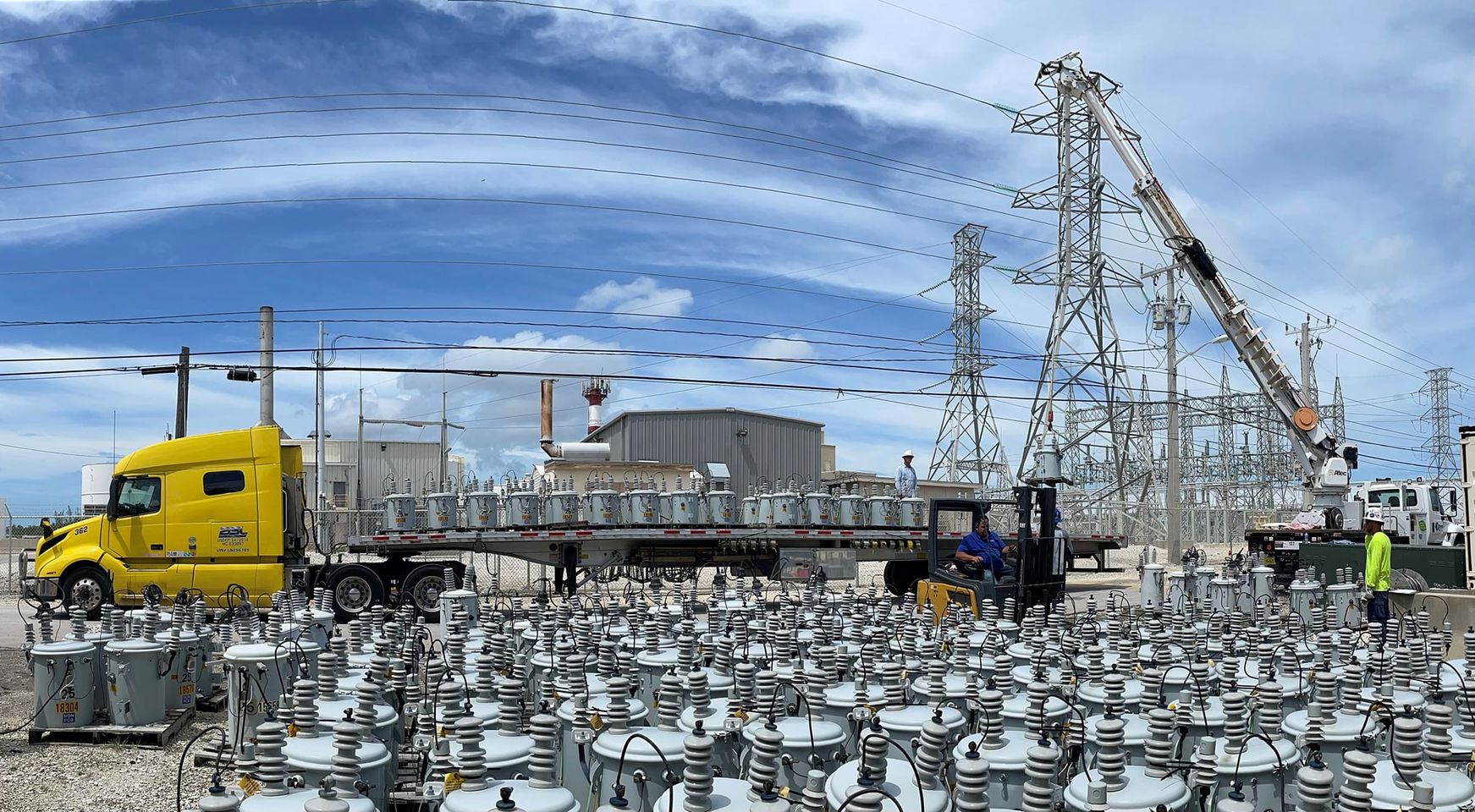
“At KEYS we are well aware of the challenges utilities face in restoring power after a major weather event,” said KEYS’ General Manager and CEO Lynne Tejeda.
“While boots on the ground do the physical work of restoring power, equipment shortages can adversely impact their progress. KEYS was not called on to assist with post-Hurricane Ida restoration efforts, but the shipment of these transformers will assist restoration efforts and help to light the path to recovery for our fellow citizens in Gulf Coast,” she said.
“Florida public power, and particularly Keys Energy, has been impacted time and time again from hurricanes,” said Amy Zubaly, Executive Director of the Florida Municipal Electric Association.
“We understand the importance of not just relying on mutual aid crews for help with restoration but the need for materials and supplies beyond what we normally have on hand. We’re proud to be able to help another public power in need however we can,” she said.
APPA Celebrates National Hispanic Heritage Month
September 14, 2021
by APPA News
September 14, 2021
To honor National Hispanic Heritage Month – commemorated September 15 to October 15 – the American Public Power Association’s Public Power Current is proudly spotlighting our Hispanic heritage colleagues across the United States and our U.S. territories. Observance began in 1968 as “Hispanic Heritage Week” and was later expanded by federal law to cover a 30-day period beginning on September 15. That date marks the independence anniversary for Costa Rica, El Salvador, Guatemala, Honduras, and Nicaragua; Mexico and Chile celebrate their independence days on September 16 and September 18, respectively.
We begin our coverage by profiling some of public power’s Hispanic heritage leaders at the chief executive and governing body leadership levels. We hope you enjoy getting to know them better as much as we are honored to help celebrate the rich histories, cultures, and contributions of our fellow colleagues whose ancestors came from Spain, Mexico, the Caribbean, and Central and South America.
Our second feature article, to follow in early October, will detail how mentorship programs have helped to develop and promote Hispanic heritage employees at public power utilities.
Imperial Irrigation District (IID) – Imperial, California
Henry Martinez serves as IID’s chief executive, managing one of the nation’s largest irrigation districts and California’s third largest public power provider. He has over 45 years of utility sector experience with increasing responsibility involving administration, technical, and field organization positions. His tenure includes nearly 25 years with Southern California Edison, 10 years with the Los Angeles Department of Water and Power, and seven years with the Tennessee Valley Authority. An engineer by training, he also pursued graduate-level executive training at Pepperdine University and at the University of Virginia.
Having worked for both investor-owned and public power utilities, Martinez appreciates how not-for-profit utilities work to safely provide reliable, low-cost electricity and high-quality customer service. “It also means you get a utility that cares about the overall well-being and growth of your community by providing a transparent and committed public provider to the communities it serves,” he said.
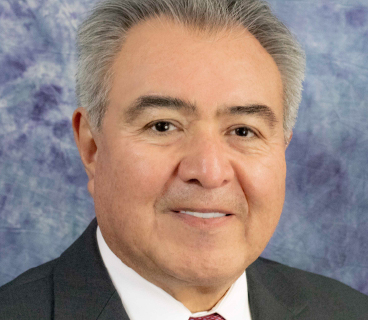
The community-owned utility also strives to reflect the population it serves. IID serves Riverside and Imperial counties, the latter of which shares a border with Mexico and where Hispanics comprise 84% of the population.
Amongst the members of IID’s governing board is Division 5 Director Norma Sierra Galindo. A homegrown talent, she has served as both the board’s president and vice president during her nearly decade-long tenure and, before that, was appointed to IID’s Energy Consumers Advisory Committee, serving for eight years.
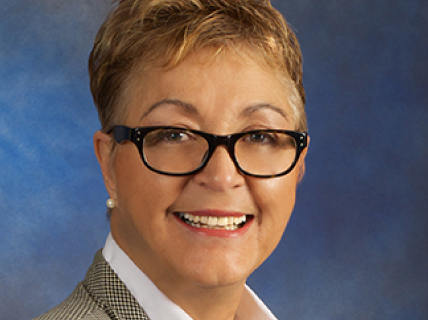
Martinez is the first of our Hispanic heritage leaders to offer advice on recruiting and mentoring more Hispanic workers to join and eventually lead public power utilities. “Expanding the opportunities for high-potential talent to network and develop leadership and managerial skills for personal growth” is important within IID, he said.
“Give them the tools and skills needed to accelerate their development into the executive ranks, bring them a step closer into leadership roles, and promote the value of a bicultural influence,” he added. Martinez said that providing scholarships to local Hispanic students who want a career in public power can help show them how to become an influential Hispanic leader within the organization. “Also, joining a STEM advisory board at a local college or university to provide curriculum input and work with students to develop career options following graduation,” he advised.
Puerto Rico Electric Power Authority (PREPA) – San Juan, Puerto Rico
Efran Paredes Maisonet, P.E., serves as Executive Director of PREPA. He joined PREPA in February 2000 as General Engineer Supervisor in the Planning and Research Division, under which he was responsible for overseeing the planning and research for PREPA’s Transmission System Division.
In 2009, he was appointed under the administration of former Governor Luis Fortuño as Deputy Advisor to the Governor in the Energy and Environment Sectors. In 2013, Paredes returned to PREPA in his former position as General Engineer Supervisor of Planning and Research Division. In 2015, he was promoted to Director of the Planning and Research Division, where he oversaw the main areas, Generation, Transmission, Distribution, Renewables, Engineering Systems, Rates and Forecasts, of the power system from a planning standpoint.
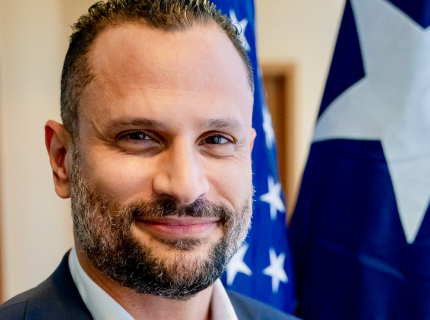
In August 2020, PREPA’s Governing Board selected him as the Interim Executive Director for PREPA and in November 2020 he was appointed as Executive Director. He also serves as a Member of the Board of PREPA Net, a division of PREPA that offers a full range of information technology services.
Paredes said that being part of the public power sector “represents a balance between two sides of a coin. On one side, you have the opportunity to be part of the technological development that will allow energy to reach every home and serve people in practically every aspect of their lives. You provide security to their homes, contribute to economic development in all sectors, such as tourism, entertainment, manufacturing industries, hospitals, pharmaceuticals, trade, in other words, energy is crucial to provide stability and development.”
On the other side, “you have the responsibility to evolve, to transform the energy sector, to adapt it to the current times, facing the future, looking for new sustainable, reliable, cost-effective and efficient alternatives to ensure the energy supply,” he said.
“I have worked for the Puerto Rico Electric Power Authority for the past 20 years, and exactly a year ago I became Executive Director of this public corporation and I am proud to be part of Puerto Rico’s history and to contribute positively to the transformation and evolution of the energy system.”
When asked if he has any advice for recruiting and mentoring more Hispanic workers to join the public power ranks, Paredes said that being a mentor is having the role as a trusted advisor. He noted that PREPA currently employs over 1,300 Hispanic workers, working in different areas from generation, dams, irrigation and administration.
“During the past 20 years at PREPA I have had the opportunity to meet and learn from various people with whom I have had the opportunity of working with, and in the same way shared my knowledge and experiences,” he said.
“While I was working as a university lecturer my goal was to support and motivate my students to learn more about the public power systems,” Paredes noted. He was eager for them to “desire in contributing their knowledge to the energy transformation of our island, a way of them giving back but mainly helping the Power Authority’s transformation.”
He said that every day “without a doubt is a challenge, every day we learn something new, every day is an opportunity to become part of the present and the future of the main source of energy for Puerto Rico.”
Paredes studied at the University of Puerto Rico, Mayagüez Campus, where he obtained his Bachelor of Science Degree in Electrical Engineering. In May 1999, he graduated from University of Puerto Rico, Mayagüez Campus, earning his second degree fr0m his Alma Mater, a Master of Science in Electrical Engineering. His master’s thesis research was on the Determination of Required Rapid Response Spinning Reserve to avoid under Frequency Load Shedding under Generation Deficiency Conditions in Puerto Rico’s Electric Power System. After completing his engineering degree, he passed the Fundamentals of Engineering examination, becoming a Licensed Electric Engineer.
New York Power Authority (NYPA) – White Plains, New York
Bethaida “Bea” Gonzalez serves as one of seven gubernatorial appointees to NYPA’s Board of Trustees. Born in Puerto Rico, she is a longtime Syracuse resident and a graduate of the State University of New York at Binghamton and Syracuse University’s Maxwell School of Citizenship and Public Affairs. Gonzalez has over 40 years of experience in higher education with a distinguished record of public service. She has been appointed to high-level positions at Syracuse University and has been elected to public office three times.

In 1991, she was the first Latina to be elected to the board of education in the City of Syracuse and, in 2001, was the first Latina elected as president of the city’s Common Council. In 2017, she received the University Professional Continuing Education Association’s Julius M. Nolte Award for Extraordinary Leadership. Last year, the Allyn Foundation – in partnership with Syracuse University, the COVID-19 Relief Fund, the Gifford Foundation, Reisman Foundation and the United Way – developed the “Bea Gonzalez Summer Scholars” program that serves over 800 youth.
She was drawn to public power as it represents a “common good” community asset to be leveraged. “Public power can be an economic catalyst – a leader in the shift from fossil fuels, and a leader in addressing issues of access, equity and inclusion by its actions and decisions,” she said. More can be done to bring awareness about opportunities at public power utilities for young, underrepresented people. She suggested “building partnerships with school districts, working with educational opportunity programs at our institutions of higher education, youth development work with community- and faith-based organizations, and hosting events and programs for students to learn more about the many career opportunities within public power” as examples.
Her work ethic and a sense of responsibility to doing a good job are rooted in her Hispanic heritage. “These values were modeled for me by multiple generations of my family,” she said. “I stand on the shoulders of some amazing Latina women (and men) and have a responsibility to pay it forward. As a first-generation high school graduate, college graduate, elected official and many other firsts, it is imperative that I insure there be a second and third. I cannot be the first and the last.”
Omaha Public Power District (OPPD) – Omaha, Nebraska
Javier Fernandez joined OPPD as vice president and chief financial officer in 2017 before being selected by the Board of Directors to serve as president and chief executive officer in July 2021. We appreciate the opportunity to have recently interviewed him on our Public Power Now podcast.
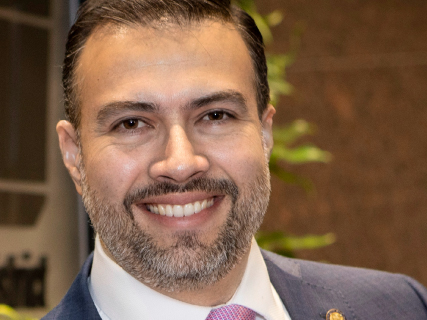
Fernandez previously worked for the Bonneville Power Administration in Portland, most recently serving as chief financial officer, and had worked for private financial services firms where he advised municipal entities before that. Fernandez holds a bachelor’s degree in economics from the Instituto Tecnológico Autónomo de México in Mexico City, a Master of Business Administration degree from Yale University, a Utility Management Certificate from Willamette University in Oregon, and a Utility Executive Certificate from the University of Idaho. He currently serves as a board member of the Federal Reserve Bank of Kansas City (Omaha Branch), Bellevue University in Nebraska, and for Habitat for Humanity – Omaha.
Fernandez joined the public power sector after being inspired by his own journey to America. He left his home country and adopted the United States as his own after embracing the American Dream. Having studied America’s history during high school in Mexico City, “I fell in love with the language in the Declaration of Independence: ‘We hold these truths to be self-evident, that all men are created equal, that they are endowed by their Creator with certain unalienable Rights, that among these are Life, Liberty and the pursuit of Happiness.’ Today, 21 years after having migrated into this country and now being a proud U.S. citizen, these truths ring just as true to me now as they did back then,” he reflected.
Fernandez wants to weave a purposeful thread as an industry leader. “The energy services we deliver are behind the unalienable rights quoted in the Declaration of Independence: A cleaner world and powering essential services that supports Life, customer representation in our elected boards that reflects Liberty and the pursuit of perfect power that enables Happiness. It’s a powerful triad.” He called public power a noble industry; one which serves customer-owners and where growth and learning are constants.
He also wants to help the next generation of public power leaders. “Unfortunately, the concept of public power – and public power career options – are also not widely known,” he said. “This is especially true in communities where there are no family ties or traditions” with public power. Fernandez advised being more proactive in outreach to traditionally less represented communities in our workforce and to share public power’s amazing story. “The value we deliver to the people who own these public assets is immense. We are stewards of incredibly valuable and critical assets, in an industry that is experiencing significant technological changes,” so being part of the public power solution will help our nation thrive.
Brownsville Public Utilities Board (BPUB) – Brownsville, Texas
Sandra A. Saenz serves as Vice-Chair on the board at BPUB. She was a board member on CASA of Cameron and Willacy Counties for a number of years and is the owner of Spanky’s Burgers & More, which has been in operation for more than 20 years.

“As a Hispanic female, the main advice that I would give is to get involved with your community and your local schools,” said Saenz. “The industry is rapidly changing, and we all need to be ready and willing to change with it. By staying involved within the schools in your area, this will create a great opportunity to mentor the professionals of today, tomorrow and the future.”
She noted that BPUB is in a predominantly Hispanic area, “and we put a lot of focus on recruiting locally and promoting the talents of our community in the City of Brownsville. We go to local job fairs and career days. We offer internships for high school and college students. We push our job openings on social media, and we have reached out and formed a close relationship with local colleges.”
It is “critical for BPUB to perform this outreach to educate people about who we are and build awareness of the opportunities we offer. You don’t have to leave home to get a good job and a good education; you can make a difference right here within your community,” Saenz said.
“Unlike other municipalities, public power provides the community with its own utility company, and because it is owned by the city, officials can help assure affordable rates and reliable service for its citizens. Decisions about the utility are made by people who live here and understand the challenges the area faces,” she said.
BPUB was formally chartered by the city of Brownsville in 1960 to provide electrical, water and wastewater services to its customers in the southernmost part of Texas. Under the charter, management, operation and control of the city’s combined water, wastewater and electric utility systems were delegated to the BPUB Board of Directors. The Board is composed of seven members: six appointed by the City Commission to four-year terms and the city’s mayor serving as the seventh member (ex-officio).
The utility serves 51,000 industrial, commercial and residential customers with electric service, 52,000 industrial, commercial and residential customers with water service and 52,000 industrial, commercial and residential customers with wastewater service.
Our second feature article will follow in early October. In it we will detail how mentorship programs have helped to develop and promote Hispanic heritage employees.
Michael Avanzi Named New General Manager of Wisconsin’s Kaukauna Utilities
September 14, 2021
by Vanessa Nikolic
APPA News
September 14, 2021
Wisconsin public power utility Kaukauna Utilities (KU) recently announced that Michael Avanzi has been selected as the utility’s new general manager, following the upcoming retirement of current general manager, Jeffery Feldt.
KU conducted an extensive search process to fill the position of the general manager vacancy.
For over 17 years, Avanzi has led utility engineering and operations activities.

Avanzi is currently the manager of electric construction and maintenance at public power utility Colorado Springs Utilities. In this role, he oversees all facets of electric construction, maintenance, and operation for transmission and distribution systems that serve 250,000 customers.
Avanzi and his family plan to relocate in October to Kaukauna as he will assume his new role on November 1, 2021.
Established by local residents in 1912, Kaukauna Utilities is a community-owned and operated electric utility serving 16,000 customers in Kaukauna and several surrounding communities. The utility also provides water service for customers within the city.
